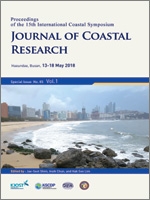Le Cozannet, G.; Duvat, V.; Salvat, B., Etienne, S.; Terorotua, H.; Garcin, M.; Lecacheux, S., and Montaggioni, L., 2018. Modelling the Response of Atoll Reef Islands to Multi-Millennial Sea Level Rise from the Last Glacial Maximum to the Coming 10kyr: the Case of Mururoa Atoll (Tuamotu, French Polynesia). In: Shim, J.-S.; Chun, I., and Lim, H.S. (eds.), Proceedings from the International Coastal Symposium (ICS) 2018 (Busan, Republic of Korea). Journal of Coastal Research, Special Issue No. 85, pp. 511–515. Coconut Creek (Florida), ISSN 0749-0208.
Composed of biodetritic sediments and lying just a few meters above present sea-level, atoll reef islands are liable to be highly exposed to coastal flooding and shoreline erosion. Nevertheless, the analysis of multi-decadal shoreline change has shown that most reef islands either remain stable in area or are expanding within the context of current sea level rise. This article addresses the key issue of future atoll-island persistence using a simple morphodynamic model based on the computation of sediment production and fluxes, vertical coral growth and reef island accretion, with special reference to Mururoa Atoll (French Polynesia). The model parameters are calibrated from previously gained stratigraphic frameworks and sediment production rates. While a proper validation is a challenge with the scares data available, the model fits well with the atoll-rim and atoll-islands evolution schemes of Mururoa Atoll since the last glacial maximum. Multi-millennial projections of sea-level rise (Clark et al., 2016) are used to examine future reef island response to rising sea-level. Assuming that all sediment volumes available on the atoll rim maintain in place and that the sediment production remains unaffected by ocean warming and acidification, the reef is interpreted as able to catch up sea level rise in the near future. Even in this very optimistic evolution scheme, the new reef edifice would be filnally drown in a high carbon emission scenario. The present study, along with others, strongly suggests that the persistence of reef islands in the future requires the conservation of already available sediments together with a continued production of coral detritus, not only from the outer slopes, but also on the atoll rim as water depths increase.





